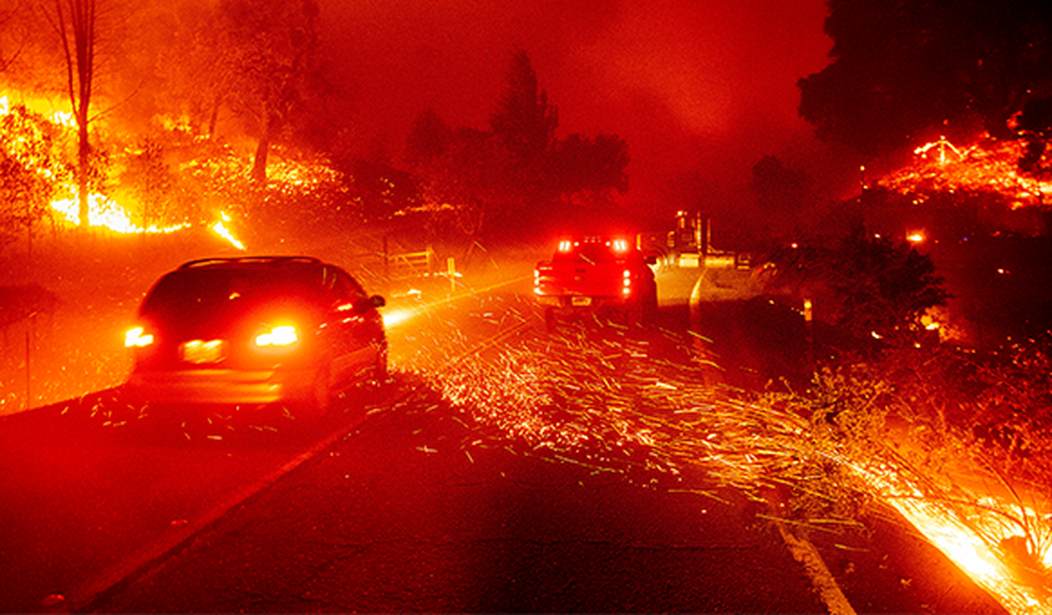The taiga is one of the world's largest biomes. It's a vast boreal forest that circles the North Pole, from Alaska and Canada through Siberia and northern Europe, ending in Scandinavia. With millions of square miles of larch, pine and spruce, birch, willow, and alder, the taiga absorbs more carbon dioxide and produces more oxygen than the globe's rain forests. It's a big, big ecosystem, and as it happens, it's one I see every day, living as I do on the edge of the taiga in south-central Alaska.
But in the Great White North, America's neighbor to the north (or east, in the case of Alaska), Canada has suffered a lot of wildfires in the last year or so, and those fires spewed out more carbon emissions than most of the developed world. But it's not Canada's industry that is causing all this; it's Canada's wildfires in Canada's great boreal forest.
And it's making climate scolds nutty.
The wildfires that ravaged Canada’s boreal forests in 2023 produced more planet-warming carbon emissions than the burning of fossil fuels in all but three countries, research published on Wednesday has found.
Only China, the United States and India produced more emissions from fossil fuels than the Canadian fires, according to the study, which was published in the journal Nature.
The wildfires last year call into question how much carbon the forests will absorb in the future, scientists said. That, in turn, may make it necessary to reconsider calculations of how much more greenhouse gas humans can add to the atmosphere without pushing temperatures beyond current global targets.
Funny that they mention China, but then they could scarcely not mention the People's Republic, as China is building coal-fired electricity generation plants at an incredible clip, although they seem to be slowing that process down over the last few months.
Where China is concerned, mind you, I would point out that what seems to be is not always what is.
This prompts two questions:
First, how were these carbon emissions measured, and what effect have they had on temperatures? Is the increase in CO2 offset by the smoke and particulate in the air, which has a cooling effect?
Second, how are these global carbon targets determined? How do we know what the "correct" level is? How do we know what the "correct" average temperature is?
What the Canadian wildfires remind us of is a basic fact: Humans and all of their efforts are pretty puny on the enormous scales in which global climate works and the immense spans of deep geologic time in which the planet moves. As recently as the Miocene the planet was warmer than it is now, and in the Eocene, there were tropical forests in Germany. And even in the time scales that we can understand, one good volcano can have a catastrophic effect on the environment that humans couldn't hope to duplicate, such as a year without a summer.
What caused this calamitous “Year Without a Summer?” At the time, many people believed the chaos was some form of divine retribution, but most scientists now place the lion’s share of the blame on an Indonesian volcano called Mount Tambora. In early 1815, Tambora roared to life with one of the most devastating volcanic eruptions on record—an explosion 10 times more powerful than Krakatoa. Along with killing thousands of locals, the blast also spewed sulfur dioxide into the stratosphere. The ash cloud drifted across the globe in the months that followed, blotting out the sun and creating a volcanic winter.
See Related: Now The Climate Scolds Want to Turn Off Your Refrigerator-Freezer
Biden-Harris Admin. Warns of 'Inescapable Death Spiral' of Climate Change on NASA's Webpage for Kids
The taiga is big. Really, really big. Nature in its various forms dwarfs the works of we humans. When I still lived in Colorado, I was fond of taking visitors up Smoky Hill Road to a high point where one could see over Denver, nestled in the Platte Valley, and towering over it, dwarfing the city, the peaks of the Front Range. Turn 90 degrees and on a clear day, you could easily see Pikes Peak, 90 miles off.
And now, in Alaska, we are surrounded by daily reminders of how vast the Great Land is, including the hard fact that the bush swallows up people every year, some of whom are never seen again.
So, yes, wildfires can result in a lot of carbon dioxide being put into the air, along with ash, soot, and other particulates. A volcano can do much worse, spewing sulfur dioxide that causes acidic rain and ash that blocks sunlight. The planet operates on its own scale and on its own time, and we really aren't a very big part of it.
So, when an event like this comes up, and when people start wondering about adjusting our "current global targets," the first question we must ask is, "At what cost," and the second should be "What is the effect on our modern lifestyle?"
I suspect most people won't like the answer to either. Again, none of this is worth destroying the economy or our modern technological lifestyle.
We solve today's problem with tomorrow's technology. It is technological advances that make the earth cleaner and less polluted, not the converse. That, not restrictive "green" plans, should be our path forward.
This happened earlier this month:














